Leon Sametini
Leon Sametini Collection
The Rosenthal Archives recently received a collection of materials documenting the life of violinist, influential teacher and member of the Chicago Symphony Orchestra, Leon Sametini.
Sametini was born on March 16, 1886, in Rotterdam, Holland, where his father Samual was principal flute in the Royal Opera Orchestra. He showed early promise on the violin and soon became a protégé of Queen Wilhelmina of the Netherlands, who funded his study with the famed violin pedagogue Otakar Ševčík for one year.
When Sametini was 15, the Queen gifted to him an early 18th-century Serafin violin and funded his enrollment at the Prague Conservatory from 1902 until 1903. There he continued his studies with Ševčík and with then-director of the conservatory, Antonín Dvořák.
Sametini cited violinist and composer Eugène Ysaÿe as a particularly important influence on his playing, despite not formally studying with him: “It was after I had finished with all my teachers that I really began learning how to play violin: above all from Ysaÿe, whom I went to hear play wherever and whenever I could.”
A year after graduating, Sametini embarked on a decade of international travel, beginning with a six-month concert tour through Holland before moving to London and touring both England and Ireland. In 1905, he first appeared with the renowned soprano Nellie Melba, one of the first Australian classical musicians to win international recognition. Sametini also gave recitals throughout 1907 and 1908 with Australian contralto Ada Crossley and her eponymous Concert Company. Also supporting Crossley in her tour of England was composer and pianist Percy Grainger. With Crossley’s company, Sametini went on to tour Australia and New Zealand, as well as India and Indonesia, in 1908.
In 1912, Sametini departed London for Chicago, where he had accepted a position as the head of the violin department at the Chicago Musical College (now a division of the Chicago College of Performing Arts at Roosevelt University), a position he would hold for the remainder of his life. Soon after his arrival, Sametini rehearsed Brahms’s Violin Concerto with Frederick Stock, and it became clear that there were plans in the works for him to soon perform with the Theodore Thomas Orchestra (as the ensemble was then known).
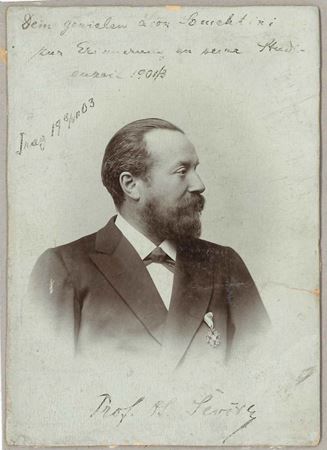

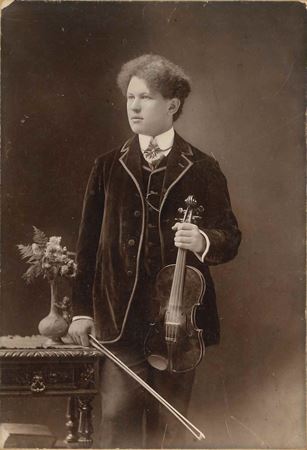
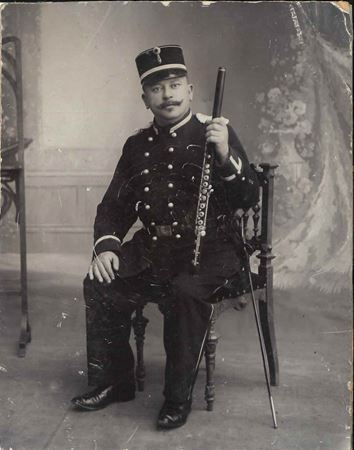
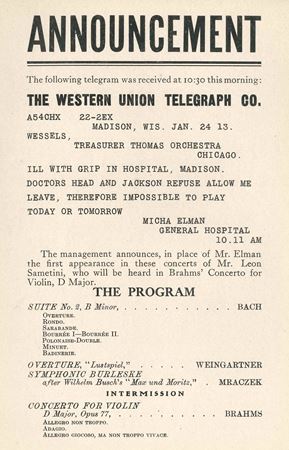
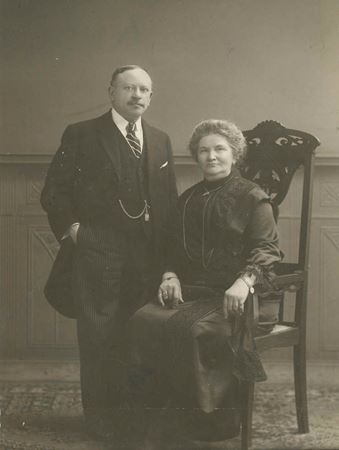
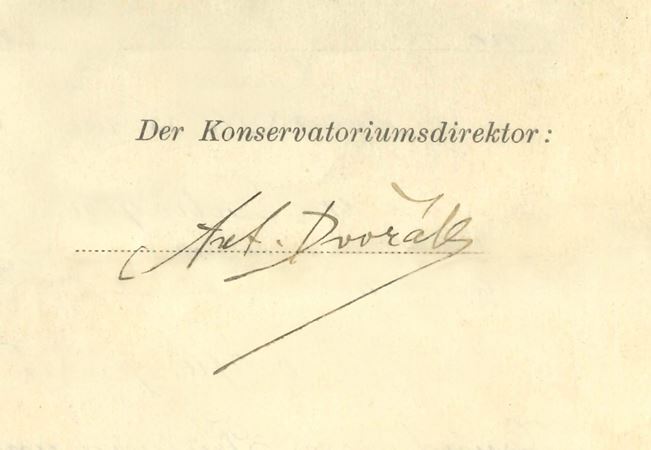
However, this opportunity came about sooner than anticipated. Mischa Elman was scheduled to perform Saint-Saëns’ Third Violin Concerto with the Orchestra on January 24 and 25, 1913. However, Frederick Wessels, the Orchestral Association’s manager, received a telegram from Elman at 10:11 a.m. on January 24, stating that Elman was “ill with grip [the flu] in hospital, Madison [Wisconsin]. Doctors Head and Jackson refuse to allow me leave, therefore impossible to play today or tomorrow.”
Stock immediately contacted Sametini, who, with mere hours’ notice, replaced Elman and performed Brahms’ Violin Concerto with the Orchestra. In spite of these unfavorable circumstances, the violinist’s dramatic debut was received enthusiastically by Chicago audiences and critics. Sametini earned “much applause and great success,” wrote Maurice Rosenfeld in the Chicago Daily News, and "belongs to the list of brilliant young violin virtuosos. . . . Sametini’s playing of the difficult Brahms concerto disclosed him to be an artist of eminent qualities [with the] technical equipment of the leading virtuosos of the day." In the Chicago Tribune, Glenn Dillard Gunn added, "Such a feat inspires respect. It attests to the courage and decision of character as well as to abundant talent and sterling qualities of musicianship. These were the salient elements revealed in [Sametini’s] interpretation.”
Sametini performed a similar act of musical heroism just a week later, on February 2, 1913, with the Chicago Grand Opera Company. He stepped in as a last-minute replacement for Efrem Zimbalist, performing the final two movements of Mendelssohn’s Violin Concerto along with Saint-Saëns’ Introduction and Rondo capriccioso. “Mr. Sametini proved again his right to be reckoned among the foremost artists of he city with a musicianly performance . . . singing qualities of tone, with accentuation of rhythm, and with musical phrasing,” wrote the critic in the Chicago Examiner.
The violinist became a frequent soloist across the city and surrounding areas, and Sametini would feature as soloist with the Chicago Symphony Orchestra on two more occasions. On December 20 and 21, 1918, he appeared with the CSO playing Saint-Saëns’ Third Violin Concerto, conducted by Eric DeLamarter. Just over a decade later, on December 28 and 29, 1928, he returned, this time performing Lalo’s Violin Concerto in F minor and Saint-Saëns’ Introduction and Rondo capriccioso under Stock’s baton. At Stock’s invitation, Sametini joined the Orchestra’s first violin section for the 1942-43 season. He died of a heart ailment in Chicago on August 20, 1944, at the age of 58.
Dinner given in honor of Leopold Auer by the American Guild of Violinists on April 14, 1918; Auer is on the far left, Frederick Stock bottom left, Sametini bottom right, and 17-year-old Jascha Heifetz in the center
Kaufmann & Fabry photo, Leon Sametini Collection
Leon Sametini is best remembered for his contributions as a pedagogue, working with many notable violinists, and his teaching philosophy is reflected in the diverse achievements of his protégés. He encouraged his students to not only consider a career as a soloist, but also to explore the broad range of opportunities available in an orchestra. Sametini recognized the distinct skills required of both the soloist and the orchestral violinist, treating both roles with impartiality and encouraging his students to pursue whichever best played to their strengths.
Writing in The Musical Leader, Sametini expressed his philosophy. “There is every opportunity in this country to become an able musician and a great violinist, and those who do not attain the rank of soloists need not feel that they are any less musicians on that account. Their unique talents simply make them better orchestral musicians than soloists, and who is to say there is any degree of superiority between these two branches of the same art?”
Sametini’s students included many orchestral string players, including several members of the Chicago Symphony Orchestra: William Faldner (violin, 1956–1994), Victor Charbulak (violin, 1922–1967), Samuel Thaviu (violin, 1934–1937) and Sheppard Lehnhoff (viola, 1930–45 and 1953–1978). Milton Preves also studied with Sametini before being appointed to the CSO’s viola section by Frederick Stock, achieving the ranks of assistant principal and principal in 1936 and 1939 respectively, serving until his retirement in 1986. Mildred Brown studied with Sametini in 1915 before becoming a charter member of the Civic Orchestra during the 1919–20 season. Brown was invited to return to the Civic by Stock in 1922, becoming the ensemble’s first female concertmaster. Fred Spector, another of Sametini’s students, also was concertmaster of the Civic before joining the CSO’s first violin section in 1956, serving until his retirement in 2003. Sametini also taught composer and violinist Silvestre Revueltas, whose works have been performed by the Orchestra on several occasions.
The Leon Sametini Collection in the Rosenthal Archives contains the violinist and teacher’s musical memorabilia from his decades of performance, including clippings of concert reviews from his years as an international soloist, as well as autographed portraits of his many friends, teachers and collaborators throughout the musical world.
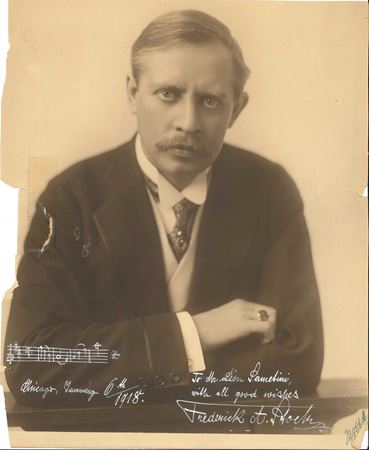
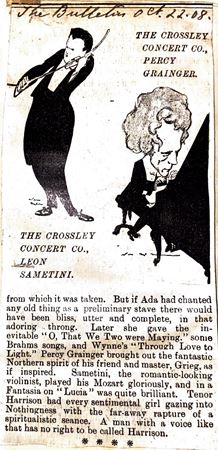
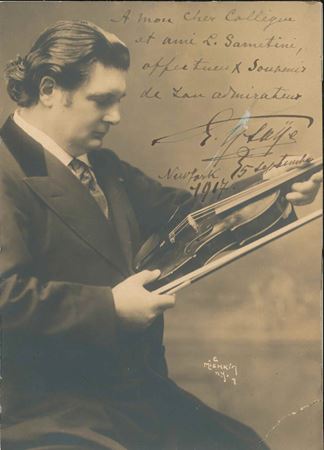
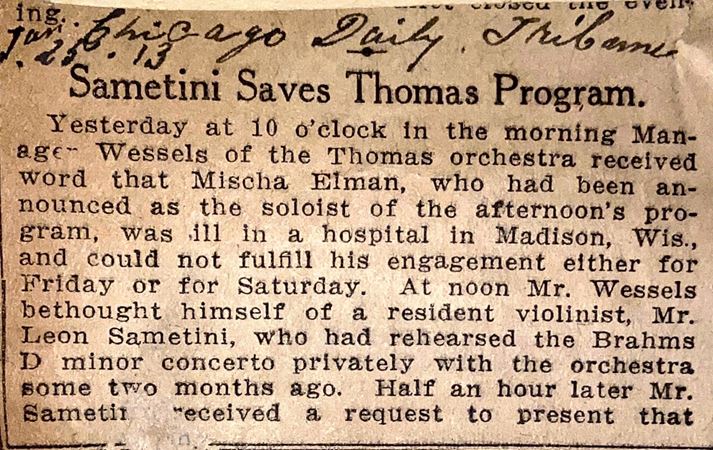
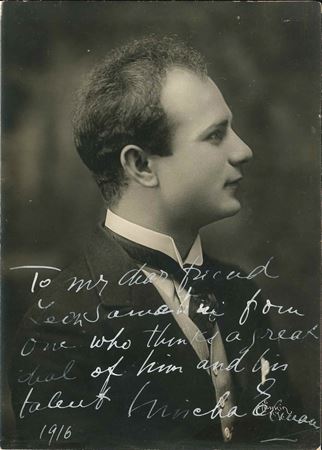
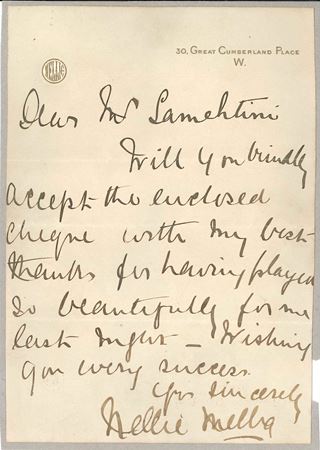
This article also appears here.



